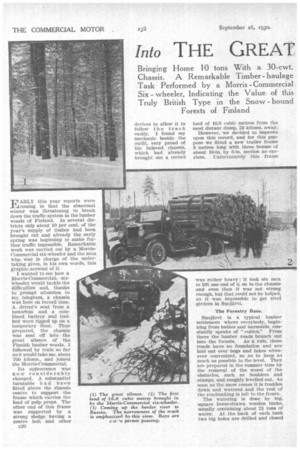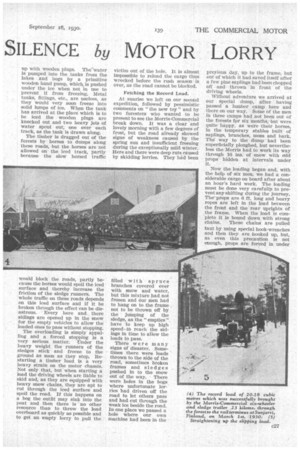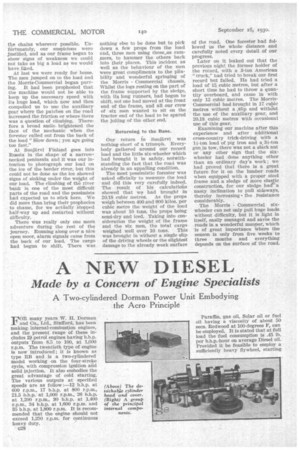Into THE GREAT SILENCE by MOTOR LORRY
Page 48

Page 49

Page 50

If you've noticed an error in this article please click here to report it so we can fix it.
Bringing Home 10 tons With a 30-cwt. Chassis, A Remarkable Timber haulage Task Performed by a Morris Commercial Six wheeler, Indicating the Value of this Truly British Type in the Snow bound Forests of Finland
EARLY this year reports were coming in that the abnormal winter was threatening to break down the traffic system in the lumber woods of Finland. In several districts only about 10 per cent, of the year's supply of timber had been brought out and already the early spring was beginning to make further traffic impossible. Remarkable work was carried out by a MorrisCommercial six-wheeler and the man who Was in charge of the undertaking gives, in his own words, this graPhic account of it.
I wanted to see how a Morris-Commercial: six'Wheeler would tackle the difficulties and, thanks ' prompt attention to lay telegram, a chassis was here on record time. A., driver's seat from a, motorbus and a combined, battery and toolbox were rigged up on a temperary floor. Thug prepared, the chassis was sent off into the great silence of the Finnish lumber Woods. I followed by train so far as it would take me, about 700 Idioms., and joined the Morris-Commercial.
Its appearance was now considerably changed. A substantial turntable had b een fitted above the chassis centre to support the frame which carries the load of pulp props. The other end of this frame was supported by a strong sledge having a centre bolt and other c26 devices to allow it to follow the track easily. I found my mechanic beside the outfit, very proud of his beloved chassis, which had already brought out a record load of 16.8 cubic metres from the most distant dump, 23 idioms. away.
However, we decided to improve upon this record, and for this purpose we fitted a new trailer frame 8 metres long with three beams of abOut 10-in. by 6-in. section as carriers. Unfortunately this frame was rather heavy ; it took six men to lift one end of it on to the chassis and even then it was not strong enough, but that could not be helped, as it was impossible to get steel girders in Suojarvi.
The Forestry Base.
Suojiirvi is a typical lumber settlement where everybody, beginning from babies and barmaids, constantly speaks of " cubics." From there the lumber roads branch out into the forests. As a rule, these roads have no foundation and are laid out over bogs and lakes whenever convenient, so as to keep as much as possible to the level. They are prepared in the summer time by the removal of the worst of the obstacles, such as boulders and stumps, and roughly levelled out. As soon as the snow comes it is trodden down and watered and the rest of the roadmaking is left to the frosts.; . The watering is done by . big, square horse-drawn wooden tanks, usually containing about 21tons of water.. At the back of each tank two big holes are drilled and closed
up with wooden plugs. The water is pumped into the tanks from the lakes and bogs by a primitive wooden hand pump, which, is pushed under the ice when not in use to prevent it from freezing. Metal tanks, fittings, etc., are useless, as they would very soon freeze into solid lumps of ice. When the tank has arrived at the place which is to be iced the wooden plugs are knocked out and two heavy jets of water spout out, one over each track, as the tank is drawn along.
The timber is dragged out of the forests by horses to dumps along these roads, but the horses are not allowed on the iced track, partly because the slow horsed traffic would block the roads, partly because the horses would spoil the iced surface and thereby increase the friction of the sledge runners. The whole traffic on these roads depends on this iced surface and if it be broken through the effect can be disastrous. Every here and there sidings are opened up in the snow for the empty vehicles to allow the loaded ones to pass without stopping.
The overloading is simply appalling and a forced stopping is a very serious matter. Under the heavy weight the runners of the sledges stick and freeze to the ground as soon as they stop. Restarting a timber load is a very heavy strain on the motor chassis. Not only that, but when starting a load the driving wheels are liable to skid and, as they are equipped with heavy snow chains, they are apt to cut through the iced surface and spoil the road. If this happens on a bog the outfit may sink into the peat and then there is no other resource than to throw the load overboard as quickly as possible and to get an empty lorry to pull the victim out of the hole. It is almost impossible to reload the cargo thus wrecked before the rush season is over, as the read cannot be blocked.
Fetching the Record Load.
At sunrise we left on our second expedition, followed by pessimistic comments on "the new toy" and by two foresters who wanted to be present to see the Morris-Commercial break down. It was a clear and lovely morning with a few degrees of frost, but the road already showed signs of weakness caused by the spring sun and insufficient freezing during the exceptionally mild winter. Here and there were deep ruts caused by skidding lorries. They had been filled with spruce branches covered over with snow and water, but this mixture had not frozen and Our men had to hang on to the frame _ not to be thrown off by the jumping of the sledge, as the "empties " have to keep up high speed to reach the sidings in time to allow the loads to pass.
There were many signs of disaster. Sometimes there were loads thrown to the side of the road, sometimes broken frames and sledges pushed in to the snow out of the way. There were holes in the bogs where unfortunate lorries had driven off the road to let others pass and had cut through the weak ice beside the road. In one place we passed a hole where our own machine had been in the pre,vious .day, up to the frame, but out of which it had. saved itself after a few pine saplings had been chopped off and thrown in front of the driving wheels.
Without adventure we arrived at our special dump, after having passed a lumber camp here and there on our way. Some of the men in these camps had not been out of the forests fpr six months,but were quite happy, as were their horses, in the temporary stables built of saplings, branches, moss and bark. The way to the dump had been superficially ploughed, but nevertheless the Morris had to work its way through 16 ins, of snow with add props hidden at intervals under it.
Now the loading began and, with the help of six men, we had a considerable cargo on board after about an hour's hard work. The loading must be done very carefully to prevent any shifting during the journey. The propsare 6 ft. long and heavy ropes are left in the load between the front and the rear uprights of the frame. When the load is complete it is bound down with strong chains. These chains are pulled taut by using special hook-wrenches and then they are hooked up, but, as even this precaution is not enough, props are forced in under
the chains wherever possible. tnlcirtunately, our suspicions were justified, and as our frame began to show signs of weakness we could not take as big a load as we would have liked.
At last we were ready for •home. The men jumped on to the load and the Morris-Commercial began purring. It had been prophesied that the machine would not be able to keep up the necessary speed with its huge load, which now and then compelled us to use the auxiliary gear where the patches on the road increased the friction or where there was a question of climbing. Therefore a broad smile brightened the face of the mechanic when the forester called out from the back of the load "Slow down; you are going . too fast."
At Suojiirvi Finland goes into Russia in the shape of a narrownecked peninsula and it was our intention to photograph our load on the ice of the border river, but this could not be done as the ice showed signs of sinking under the weight of our load. The climbing of the river bank is one of the most difficult parts of the road and the pessimists had expected us to stick here. We did more than bring their prophecies to shame, for we actually 'Stopped half-way up and restarted without difficulty.
There Was really only one more adventure during the rest of the journey. Running along over a nice open moor, alarm signals came from the back of our load. The cargo had begun to shift. There was
nothing else to be done but to pick down a few props from the load and, three men using these.,as rammers, to hammer the others back into their places. This incident as well as the behaviour of the men were great compliments to the pliability and wonderful springing of the Morris Commercial chassis. Whilst the logs resting on the part of the frame supported by the sledge, with its long runners, had begun to shift, not one had moved at the front end of the frame, and all our crew of six men wanted to sit on the tractor end of the load to be spared the jolting of the other end.
Returning to the Base.
Our return fo Suojarvi was nothing short of a triumph. Everybody gathered around our record load and the little six-wheeler which had brought it in safely, notwithstanding the fact that the road was already in an appalling condition.
The most pessimistic forester was asked officially to measure the load and did this very carefully indeed. The result of his calculations showed that we had brought in 20.18 cubic metres. As the props weigh between 400 and 600 kilos. per cubic metre the weight of the load was about 10 tons, the props being semi-dry and iced. Taking into consideration the weight of the frame and the six men, the total cargo weighed well over 10 tons. This was brought in without a single slip of the driving wheels or the slightest damage to the already weak surface
of the road. One forester had followed us the whole distance and carefully noted every detail of our progress.
Later on it leaked out that the previous night the former holder of the record, with a 3-ton American "truck," had tried to break our first record but failed. He had tried a load of 15 cubic metres, but after a short time he had to throw a quantity overboard, and came in with only 12 cubic metres. The MorrisCommercial had brought in 17 cubic metres without a ,slip and without the use of the auxiliary gear, and 20.18 cubic metres with occasional use of this gear.
Examining our machine after this experience and after additional cross-country trick-driving with a 14-ton load of pig iron and a, 34-ton gun in tow, there was not a slack nut or any other sign that the sixwheeler had done anything other than an ordinary day's work ; we had proved that there is a great future for it on the lumber roads when equipped with a proper steel frame and a sledge of more elastic construction, for our sledge, hatr a nasty inclination to pull sideways, thereby increasing the resistance considerably.
The Morris Commercial sixwheeler can not only pull huge loads without difficulty, but it is light in itself, easily managed and safes the roads in a wonderful manner, which is of great importance vhere the season is only from five weeks to three months and everything depends on the surface of the road.












































































































